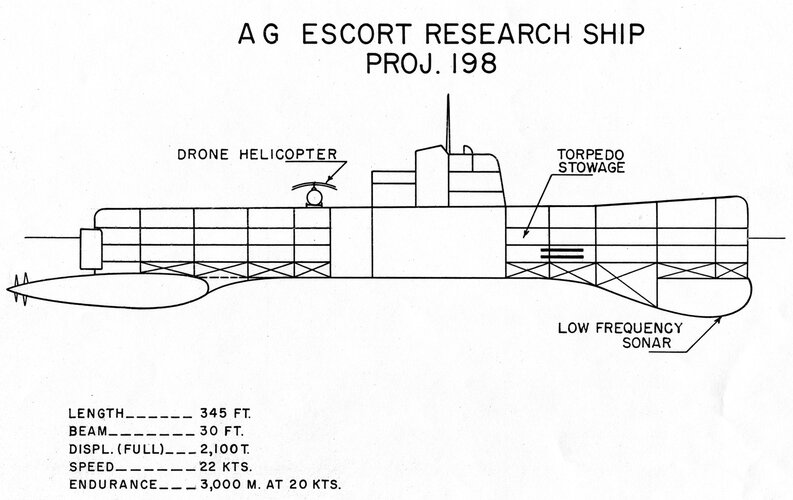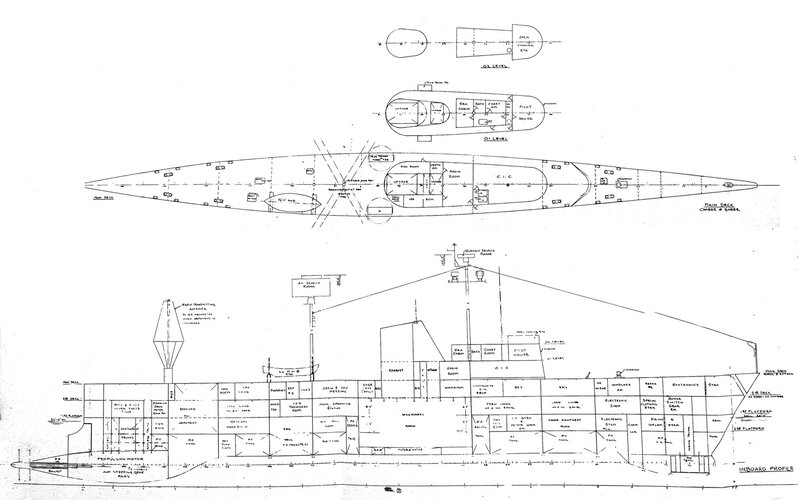Class: Escort Research Ship (AG 158)
Design: SCB Project 198 (Data as of 29 May 1959)
Displacement (tons): 1,540 light, 2,200 full
Dimensions (feet): 351' oa, 300' wl x 32' x 29.25' (including appendages)
Armament: Two triple Mk 32 torpedo tube deck mounts for Mk 44 torpedoes, four 21" hull-mounted torpedo tubes with SUBROC or equivalent system
Accommodations: 9 officers and 87 enlisted as testbed, more if combat equipment installed.
Speed (kts.): 22 sustained silent, 25 max
Propulsion (HP): 15,000
Machinery: Gas turbine electric, 2 contra-rotating screws on one shaft
Construction:
| AG | Name | Auth | Builder | Keel | Launch | Comm |
| 158 | Unnamed | Dec 1959 | -- | -- | -- | -- |
Disposition:
| AG | Name | T | Decomm | Strike | Disposal | Fate | MA Sale |
| 158 | Unnamed | | -- | -- | 27 Feb 1961 | Canc | -- |
Class Notes:
On 24 August 1955 CNO directed BUSHIPS to undertake a feasibility study for an experimental ship with long range sonar detection capabilities. Previous efforts to extend sonar ranges had focused on improving sonar equipment but little consideration had been given to the effect of hull design on the performance of this equipment. It was hoped that proper hull design could increase detection ranges by 100% or more. The single purpose of the proposed experimental ship was to design the most efficient hull envelope possible for sonar performance, and armament and other characteristics which would adversely affect sonar hull design were excluded from the design. As of 29 November 1956 it was planned to include the ship, now called a Sonar Scout, in the FY 1959 Shipbuilding and Conversion Program.
By 6 February 1958 planning for the FY 1960-65 five-year shipbuilding and conversion program included under Patrol Ships an AG (Sonar Research Ship) and an AG (Escort Research Ship). The purpose of the Sonar Research Ship was to develop a long-range sonar (LORAD) to install in a Barrier Patrol Ship (PBG), a Victory ship with AAW and ASW missiles acting like the YAGR as an ocean picket. The purpose of the Escort Research Ship was to test an experimental hull of advanced hydrodynamic design and obtain data about its sonar capabilities and limitations for the further development of an Ocean Escort. It was thus essentially a continuation of the 1955 Sonar Scout but with length increased from 250' to 300' and a smaller propulsion nacelle. Following preliminary trials of the LORAD concept in BAYA (AGSS 318), doubts in BUSHIPS about the project led in early May 1958 to the withdrawal of the FY 1960 Sonar Research Ship conversion.
On 29 July 1958 the Ship Characteristics Board issued for review proposed characteristics for an Escort Research Ship (AG), SCB Project No. 198, applicable to the FY 1960 program. Around this time the ship was given the designation AG 158 within BUSHIPS. The purpose of the ship remained as described in February 1958. Its initial function was to obtain information on noise generated by hull motion and machinery as well as the effect of such noise on underwater detection. Its design and appearance were expected to differ radically from those of a conventional escort ship, since it was to be constructed for the best underwater detection at the expense of other characteristics. The length in October 1958 was 345' oa and 300' wl (the difference being primarily the propulsion nacelle aft) and the full load displacement was 2,100t. A sustained speed of 22 knots was required, with more if possible. The propulsion system included a nacelle hung beneath the extreme after end of the hull containing a 15,000 HP electric motor driving two large slow-turning contra-rotating propellers. A gas turbine plant with two 7,500hp turbines (one base load to reach 22 knots sustained and one booster) was eventually selected to power the motor. Space and weight were reserved for an armament of two Mk 32 torpedo tubes and four 21" torpedo tubes at the waterline (probably for SUBROC) but no armament was initially to be installed. The sonar was to be the hull-mounted low frequency SQS-26 in a large dome under the bow (which essentially drove the hull design) plus a variable depth sonar in a center well. Approved characteristics for an Escort Research Ship (AG), SCB Project No. 198, effective for the FY 1960 ship were promulgated by CNO on 27 October 1958 in OPNAVINST 09010.139 but design work continued. By 29 May 1959 the sustained speed of the ship had reached 25 knots on the booster turbine with some loss in quiet operation above 22 knots. The dimensions were now 351' oa, 300' pp x 32' x 29'3" max navigational draft for a full load displacement of 2,200 tons. Accommodations were provided for 101 men including 10 officers. On 2 September 1959 the BUSHIPS Contract Design Section returned the design to the Preliminary Design Section for additional review and possible re-development, and it was not transferred back until 2 September 1960. On 18 October 1960 the Design Division was directed to hold up all work on what was now called an Escort Research Ship (AGDE) until a decision was reached on whether or not to retain the ship in the building program.
On 30 October 1958, three days after the characteristics for SCB Project No. 198 were issued, approved characteristics for an Ocean Escort (DE), SCB Project No. 199, were promulgated. This design, which became the BRONSTEIN (DE 1037) class, introduced the SQS-26 sonar into the operational navy, although the ship was too small to carry much else. On 4 January 1961 approved characteristics for an Ocean Escort (DE), SCB Project No. 199A, were promulgated. This larger, better balanced and faster (30 knot) design became the GARCIA (DE 1040) class. (The author of this website served in BRADLEY, DE 1041, from 1968 to 1970.) On 27 February 1961 CNO wrote to BUSHIPS that the characteristics for the Escort Research Ship (AG) dated 27 October 1958 had been prepared about two and a half years ago, and that since that time studies of designs for escort types had continued and experience had been gained in several respects, including bow mounted sonars, propulsion systems, hull dampening, and ASW weapons. CNO therefore felt that the ship to be built for investigating modern escort types including acoustic phenomena and sonars should be sufficiently outfitted with the equipment and weapons involved for the evaluation of modern trends. The ship should also have the potential for being an effective escort ship for fleet use. Accordingly the characteristics of 27 October 1958 had been modified to reflect the experience gained since their initial promulgation. Approved modified characteristics for SCB Project No. 198 were promulgated by CNO on 27 February 1961 with a final change (specified as for a FY 1961 ship) on 20 December 1962. CNO asked BUSHIPS to reflect these modifications in the AG (Escort Research) in the FY 1961 shipbuilding program. This new combat-capable experimental DE was known within BUSHIPS as AG(DE) 163 instead of AG 158 or AG(ER) 158, but when she was formally classified and named by SECNAV on 28 August 1963 she emerged as GLOVER (AGDE 1). With a hull and armament almost identical to the combatant GARCIA (DE 1040) class, GLOVER is not covered on this website although a photo is provided.
Ship Notes:
| AG | Name | MA | Notes |
| 158 | Unnamed | | FY 1960. Authorized Dec 1959, not built. |
Page Notes:
Compiled: 30 Jan 2022
© Stephen S. Roberts, 2022
Special sources: NARA: RG 19 Entry P 26 Box 5, RG 19 Entry P 62 Box 100 (Design Job Order File 34-60, AGDE-163); Norman Friedman, U.S. Aircraft Carriers (Annapolis, 2022), page 25 (PBG).


